Treatment with the help of the patient’s own information
in the BICOM® mobile VET bioresonance device
In contrast to other “frequency therapy devices”, BICOM® bioresonance is a method that is highly individual and perfectly tailored to the needs of the patient through the use of the patient’s own information and the possibility of testing specific wave patterns for resonance.
The patient’s own pathological and physiological information is recorded using special applicators and fed into the BICOM® mobile VET.
Depending on the therapy program, the specific wave pattern as a carrier of information is amplified, weakened or inverted and transmitted back to the patient in modulated form, which means that the transmission of information changes in clarity depending on the modulation or it disappears completely.
The treatment signals continuously adapt to the changing pathological situation of the patient. As the therapy progresses, the body’s ability to regulate is reactivated.
Find out more about this topic at our regular events. Together with veterinarians and animal naturopaths, we offer various face-to-face and online events .
The BICOM® bioresonance method is a cause-oriented, holistic treatment concept. It can narrow down the cause of the health problem in animals and find out even the hidden causes of the clinical picture.
Animals have a natural regulatory system that can also compensate for unusual influences. However, even good self-healing powers eventually reach their limits. Persistent exposure to allergens, environmental toxins, fungi, viruses, bacteria or stress and changed living conditions weaken the immune system and are often the cause of an illness. In particular, fungal infestation on the skin or chronic diseases in general are not always due to a breeding-related genetic defect, but are signs of a disturbed immune system.
The BICOM® bioresonance method is the key to successful diagnosis and therapy, especially for animals that cannot tell us exactly where it hurts or what the symptoms are. It is a gentle form of therapy that can be carried out without side effects and without additional stress for the animal.
The BICOM® mobile VET records the bioenergetic state of the animal, processes the information it contains and returns modified vibrations / therapy frequency patterns to the animal. Symptoms and stress can be diagnosed and targeted therapy can be initiated.
Through the use of endogenous and exogenous substances, the body’s own self-healing powers can be activated and imbalances that have existed for a long time can also be regulated.
REGUMED Medizintechnik are pioneers of the BICOM® bioresonance method. More than 30,000 therapists worldwide, well over 10,000 of them in Germany, successfully use their therapy concept.
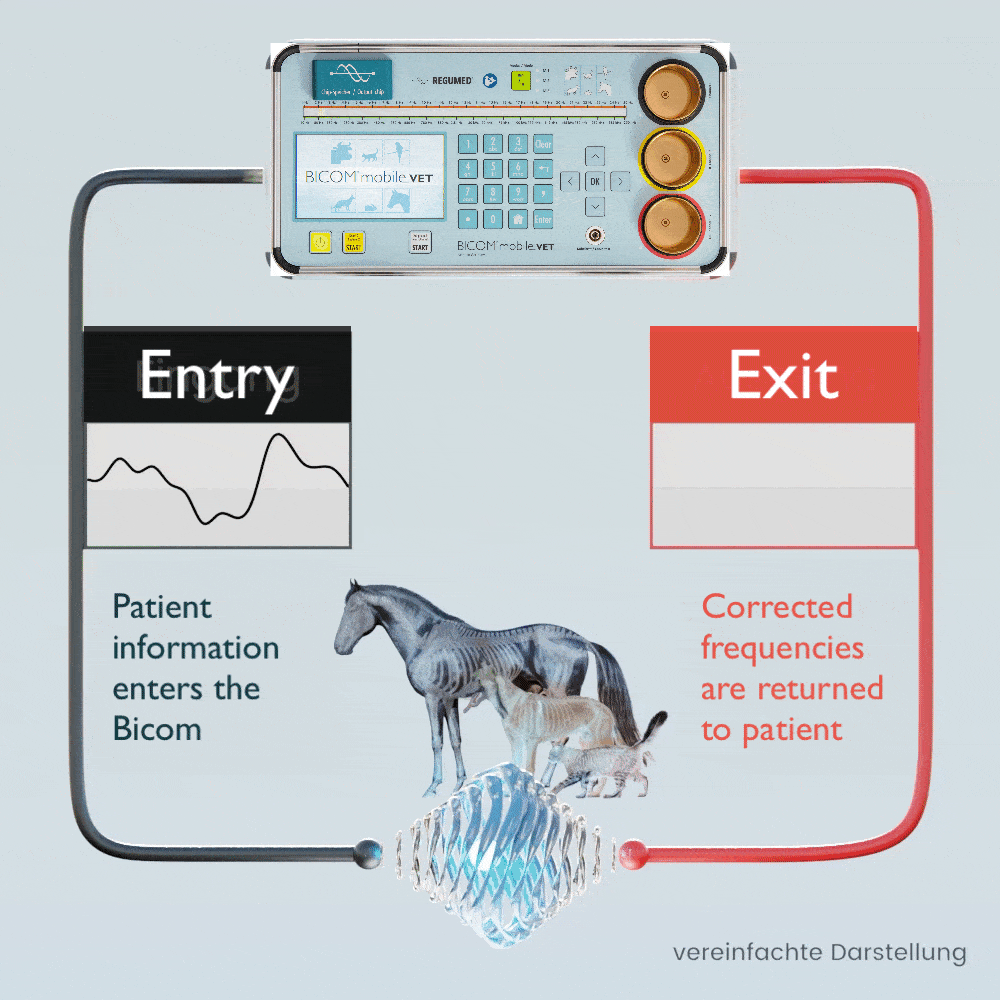
Biophysical basics of the bioresonance method
Life is only possible when three conditions are met: matter, energy and information.
We also find these aspects in conventional medicine, both in diagnostics and in therapy. For example, every drug is also a carrier of information.
Information is neither energy nor matter, it is immaterial and comparable to the meaning of a message from a sending to a receiving system.
In addition to the electrical processes in the receptor proteins and biomembranes in general, electromagnetic interactions through light (biophotons) also play a role in cell communication and the transmission of information.
Specific electromagnetic wave patterns act as information carriers. These wave patterns can be modulated by the BICOM® device in order to eliminate disturbing or stressful information in an organism.
The goal is to restore the free flow of healing information (cell communication) and thus support the self-regulation of the organism and the self-healing powers.
Individual, patient-specific information or information from native substances, digitized substances or information stored on storage media can be used for therapy.
What your colleagues are saying…
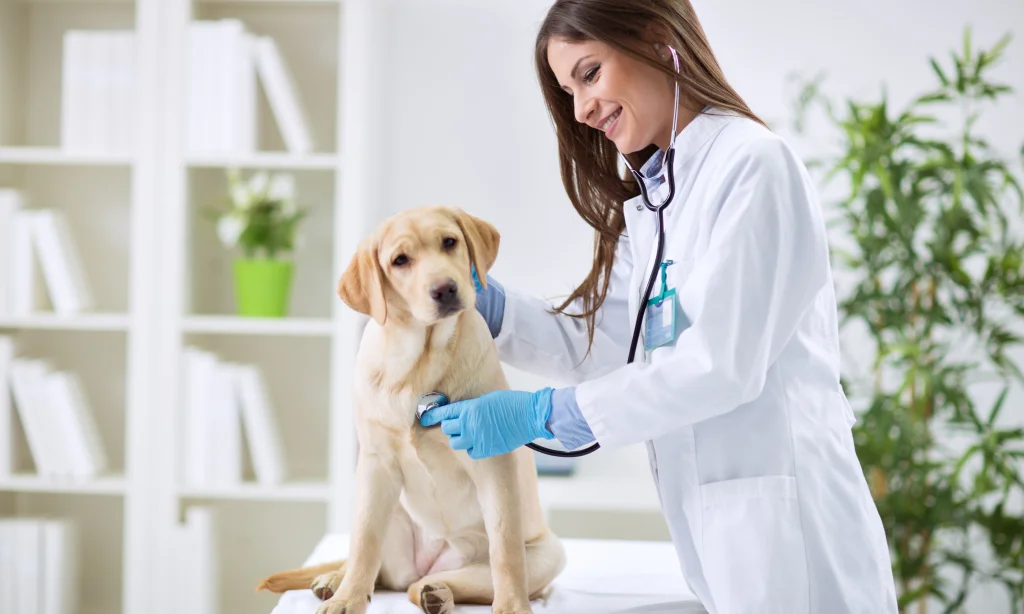
Bioresonance In Veterinary Practice
Similar to humans, dogs and cats are also at a risk of developing numerous types of diseases that can put their life at a risk and cause them to experience pain and discomfort. Unlike humans, however, dogs, cats and other animals are not able to speak out when they feel ill or experience symptoms of certain diseases. For this reason, it should be a priority amongst any pet owner to look for and to identify signs that their pet might be suffering from a disease – and, should such signs become present, to seek out a diagnosis and administer the appropriate treatments to their pet to ensure the disease is treated appropriately. Ultimately, the pet owner wants to ensure their pet lives a long and happy life, free of pain and discomfort, even though their pet is unable to communicate any potential symptoms to them.
Most Common Diseases In Pets
With cats and dogs being some of the most common pets, we are going to focus our article on these two particular species of animals. It is important to know about the many different diseases that can affect both species, including the potential symptoms they may cause. This allows a pet owner to look out for signs that their pet is developing or have developed a particular disease, and to ensure the pet owner is able to provide their pet with the appropriate treatments to help the pet find relief of the discomfort and pain they may be experiencing.
DVM360 explains that the most common types of diseases experienced by dogs, in particular, includes Otitis externa, Fleas, Dermatitis, Roundworms and Tapeworms, Colitis, Alopecia, Retained deciduous teeth and Gastroenteritis. Amongst cats, the ASPCA reports the most commonly found diseases to include Diabetes, High-Rise Syndrome, Rabies, Ringworm, Feline Leukemia Virus, Feline Immunodeficiency Virus and Heartworm. They explain that cancer also seems to be relatively common amongst cats.
Signs Of Disease In Pets
It may not always be clearly visible when a dog or a cat, or even another animal such as a horse, becomes ill. Only when the disease they are developing becomes more severe, significant symptoms may develop. This, however, may lead to a lower chance of successful treatment and may also affect their opportunity for survival. Thus, knowing about even the least significant signs of disease to look out for can help a pet owner identify, diagnose and treat a disease in their pet before it becomes too serious or even life-threatening.
The Spruce explains that pet owners should always consider their pet’s body language as very important – this is the only way for their pet to communicate with them. While not exactly in words, the body language of an animal can tell a lot about how they are feeling. If changes in their body language are detected, then it may signal the development of a disease.
Note that there are cases where emergency care may be necessary to prevent serious consequences from developing. If an animal’s gums turn pale, white or blue, then the pet owner should be worried and call a veterinary doctor for assistance. Other symptoms to never ignore include unresponsiveness, not being able to walk, problems with their breathing, dizziness and imbalance, seizures and a high body temperature.
Bioresonance Therapy In Veterinary Practice
While medication and treatment options are available to animals that have developed a disease, the costs involved with certain treatments and the possibility of side-effects developing could not be pleasant – for both the animal and the pet owner. Bioresonance therapy poses as an excellent alternative or complimentary mechanism to reduce the severity of certain diseases, ease discomfort and to relieve pain associated with some common diseases that are found in animals.
According to Bioresonance UK, this mechanism of alternative treatment has been proven as a successful option for animals ranging from small to big, including dogs and cats, and even horses. Another article on Bioresonance UK explains how one patient’s Persian cat was treated with feline calicivirus, and how bioresonance therapy assisted with soothing the symptoms the cat were experiencing. Many other testimonials provide inspiration as to how bioresonance therapy poses as a successful treatment option for addressing some common concerns amongst animals, including to treat complications that may occur after a vaccination, allergies that are present in an animal, for treating chronic cystitis and much more.
Conclusion
Pets are at a risk of developing several diseases, just like human are. The difference in the ability to communicate, however, is what makes it often more difficult to determine the possibility of a disease in a pet. Luckily, it is often possible to detect certain diseases in animals by simply being educated about the most common diseases as a pet owner, and to look out for these symptoms. Apart from the treatments that can be obtained from a veterinary clinic, bioresonance therapy also provides an effective method for reducing symptoms related to diseases in animals.
This pdf describes vet Claudia Goebbels' experience in using bioresonance.
Treatment Priorities
For gentle and optimal treatment of the causes of diseases in animals
The BICOM® bioresonance method is predestined for use with large and farm animals such as horses , but also with dogs , cats and small animals. The treatment focus of the BICOM® mobile VET is wide-ranging. It is now used for many indications.
It recognises health deficits at an early stage and is used, among other things, for the following symptoms:
sweet itch
Feed intolerances
allergies and related diseases
COB/COPD
leishmaniasis
Lyme disease
anaplasmosis
lameness in horses
hoof ulcer
Poisoning by poisoned baits, plants etc.
mauke
Feline infectious peritonitis (FIP)
Cat flu/cat disease
eye/conjunctivitis
and much more
Get advice now!
Our experts are happy to be there for you personally
Our BICOM® bioresonance experts are available to answer any questions you may have
and will be happy to advise you personally and individually.




Request more information
Quick Links
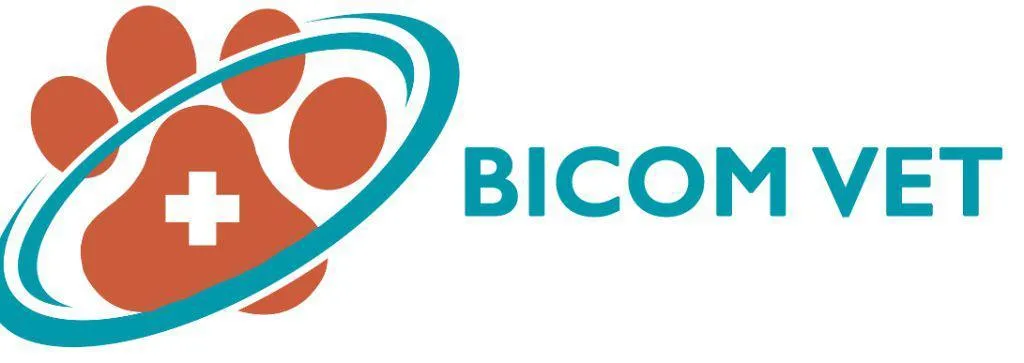
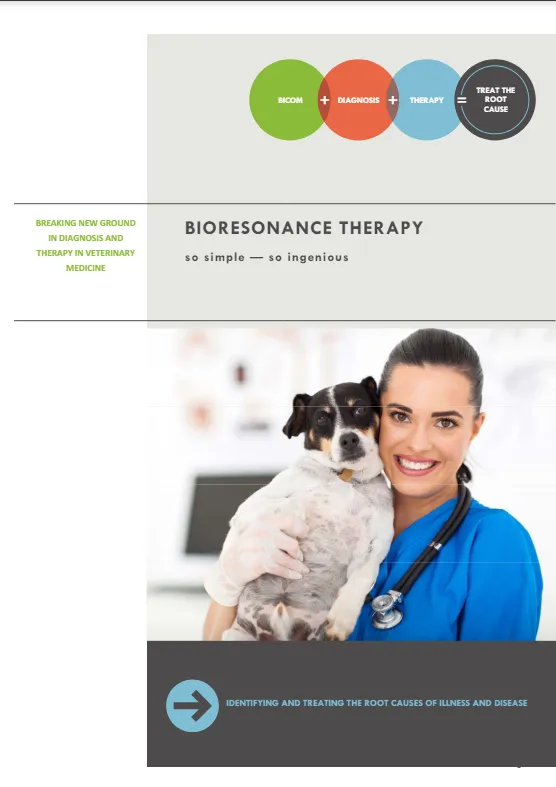
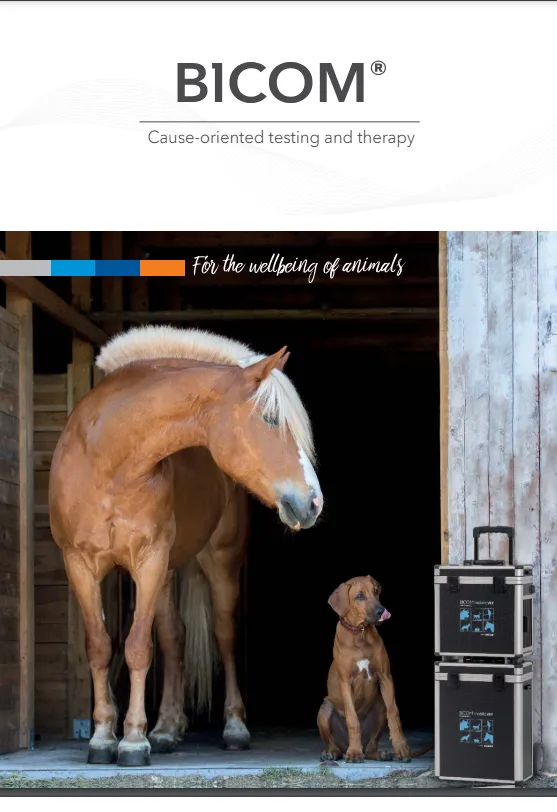


Facebook
Instagram
Mail